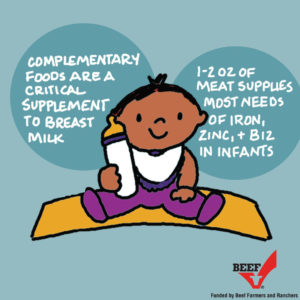 To prove beef’s role in a healthy diet, the Beef Checkoff is actively involved in human nutrition research to understand and communicate science-based information that supports beef consumption. One recent research finding is currently generating a buzz within the nutrition community – “Babies should eat meat, like beef.”
To prove beef’s role in a healthy diet, the Beef Checkoff is actively involved in human nutrition research to understand and communicate science-based information that supports beef consumption. One recent research finding is currently generating a buzz within the nutrition community – “Babies should eat meat, like beef.”
A growing body of scientific evidence illustrates the beneficial role of beef’s nutrients for physical and cognitive development in a child’s early years. Also, for the first time ever, the 2020-2025 Dietary Guidelines for Americans committee addressed the need to provide authoritative guidance regarding nutrition recommendations for children from birth to 24 months of age. Specifically, the committee recommended animal-sourced foods, such as beef, as a foundational food to support healthy growth for infants and toddlers.
 To increase awareness of the scientific evidence supporting beef as a first food for infants amongst health professionals and researchers, the National Cattlemen’s Beef Association (NCBA), a contractor to the Beef Checkoff, hosted a virtual event this past fall. “Eating in the Early Years E-Vent: An Immersive Virtual Experience on Beef’s Role in Early Childhood Nutrition” highlighted the importance and value of nutrition, health and feeding in the first 24 months of life. Leading child nutrition and feeding experts, internationally recognized nutrition researchers, healthcare specialists, childcare professionals and government agency nutrition representatives all tuned in to learn more about beef.
To increase awareness of the scientific evidence supporting beef as a first food for infants amongst health professionals and researchers, the National Cattlemen’s Beef Association (NCBA), a contractor to the Beef Checkoff, hosted a virtual event this past fall. “Eating in the Early Years E-Vent: An Immersive Virtual Experience on Beef’s Role in Early Childhood Nutrition” highlighted the importance and value of nutrition, health and feeding in the first 24 months of life. Leading child nutrition and feeding experts, internationally recognized nutrition researchers, healthcare specialists, childcare professionals and government agency nutrition representatives all tuned in to learn more about beef.
This learning experience was initially planned as an in-person event for just 30 healthcare professionals. However, after it went virtual, more than 1,275 health professionals were able to attend and learn the science behind recommending beef as a first food. The E-Vent featured live educational sessions focused on nutrition recommendations for infants and toddlers, panel discussions with leading nutrition and feeding experts and shareable social media illustrations highlighting key takeaways from each session.
O verall, at least 80 percent of respondents said the sessions’ value and quality were excellent/above average.
verall, at least 80 percent of respondents said the sessions’ value and quality were excellent/above average.
This event strengthened science-based advocacy among nutrition researchers, pediatricians and credentialed nutrition influencers, increasing the likelihood that they would recommend beef consumption during infancy and early childhood. The Beef Checkoff also hopes to inspire new research that supports beef consumption due to this event.
Childhood nutrition is a popular topic amongst parents and health experts, and the Beef Checkoff will continue to raise awareness about the importance of eating beef in the early years.
Visit the Eating in the Early Years E-Vent home page for more information about the event and educational resources.






 Ryan Goodman, Director of Grassroots Advocacy and Spokesperson Development with the National Cattlemen’s Beef Association, a contractor to the Beef Checkoff, hosted a Media Training session and Mock Interviews attendees. His session left the chefs with confidence and skills to help prepare for any kind of interview or demo opportunity – phone, radio, on-air. Laura Hagen, Senior Director of Culinary with the National Cattlemen’s Beef Association was on-hand to share the logistics of on-air demonstrations.
Ryan Goodman, Director of Grassroots Advocacy and Spokesperson Development with the National Cattlemen’s Beef Association, a contractor to the Beef Checkoff, hosted a Media Training session and Mock Interviews attendees. His session left the chefs with confidence and skills to help prepare for any kind of interview or demo opportunity – phone, radio, on-air. Laura Hagen, Senior Director of Culinary with the National Cattlemen’s Beef Association was on-hand to share the logistics of on-air demonstrations.
 The Beef Checkoff works to build consumer confidence at every stage of beef production. These investments help drive demand for beef, and are all part of a comprehensive strategy focused on safety, quality, animal welfare, antibiotic stewardship and consumer education.
The Beef Checkoff works to build consumer confidence at every stage of beef production. These investments help drive demand for beef, and are all part of a comprehensive strategy focused on safety, quality, animal welfare, antibiotic stewardship and consumer education.


